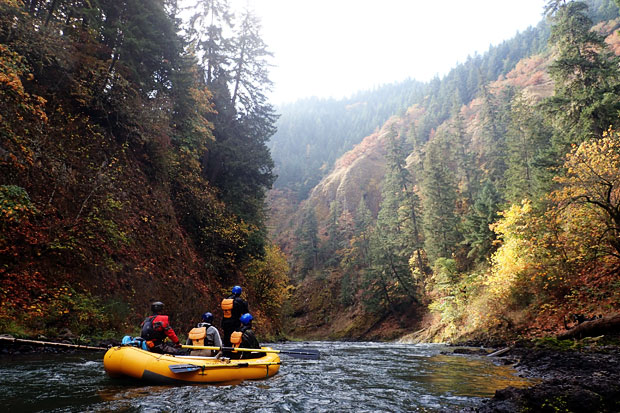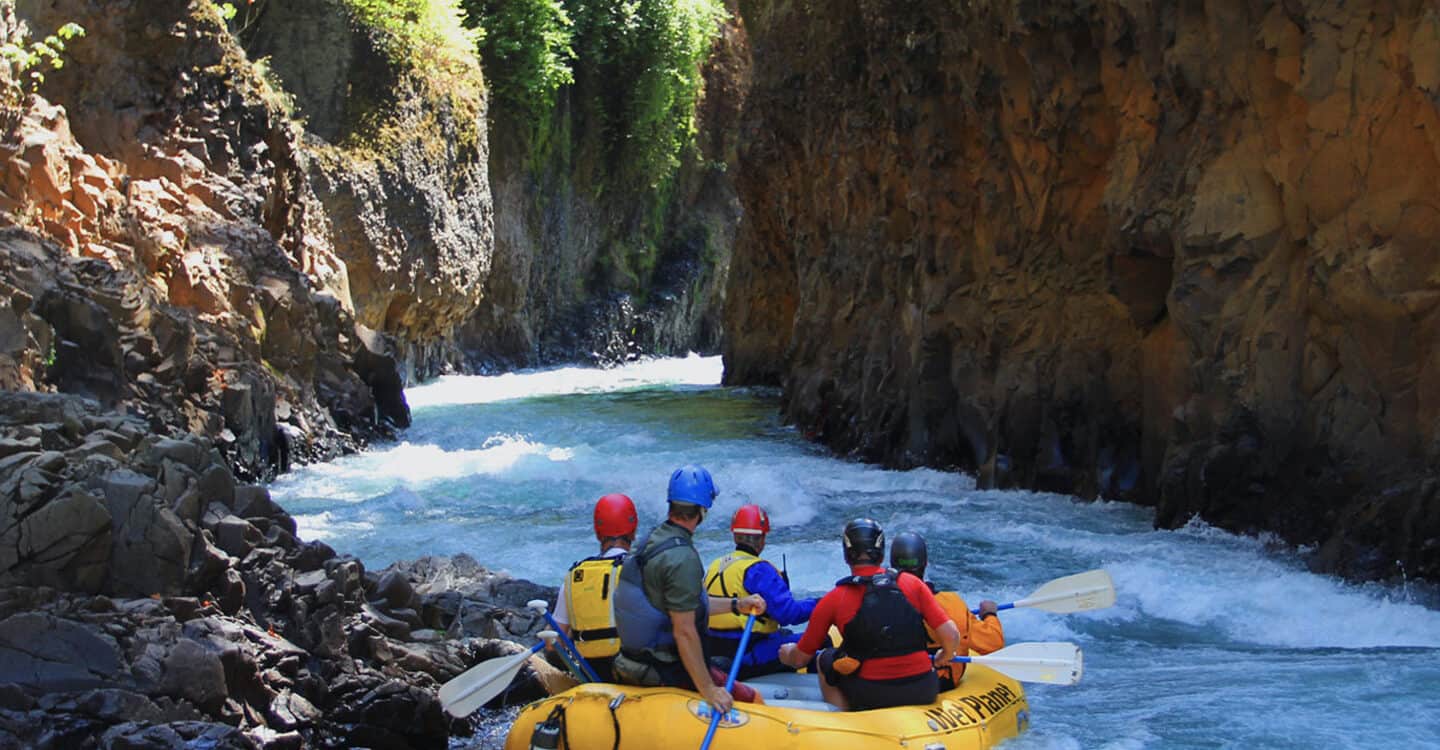Fall has arrived here in the Gorge, and so have the Tule Chinook Salmon. A few weeks ago, the water dropped to its lowest level, the trees started to gradually change, and commercial rafting trips slowed to a halt. With the fall season comes the largest run of salmon on the White Salmon River: Tule Chinook.
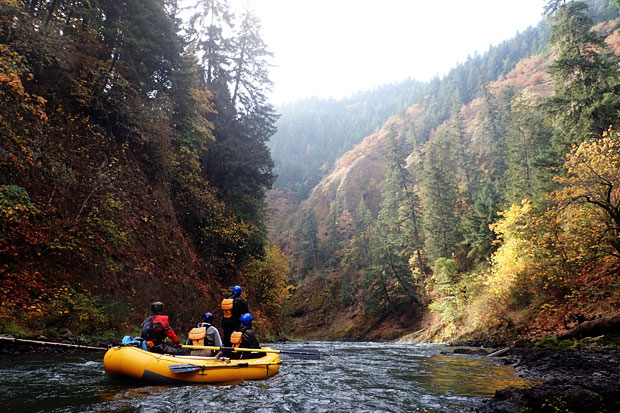
Chinook salmon are the largest species of Pacific salmon. They are born either in a river or a hatchery, and, in their smallest form, they’re typically referred to as a fry. As a fry the salmon are incredibly vulnerable. Out of 1000 of the fry which hatch, about 200 will make it to what is considered a smolt. A smolt is a slightly older salmon which is preparing to make the transition from its fresh water river into the ocean. As those 200 smolt swim out and live in the ocean, only about 10 will make it to 3 years or older. The Chinook will live in the ocean for 2-8 years, with some migrating as far as Alaska. Eventually the salmon will return to the river or hatchery where they were born, to lay their eggs and continue the cycle. Out of the 10 which made it to adulthood, two will successfully return to their river to spawn. Each female salmon will lay about 4000 eggs. They swim upstream till they find a section with suitably sized rocks to make a red. They then turn sideways and smack the bottom of the river until they create a huge indentation. Some reds on the White Salmon are at least 1.5 feet deep and have a 12 foot radius. This is where they lay their eggs. The male salmon will then come and inseminate them. All salmon eventually stop eating and die when they run. Their bodies support and help the ecosystem of their home river thrive when their eggs hatch into fry.
All Chinook salmon have the same basic life cycle, but not all Chinook are the same. You may have heard people refer to these salmon as Springers, Tule, Jacks, Jills, King, Brights, Natives, or even Pellet Heads. There are a lot of different names, so what’s the deal? Chinook salmon are categorized by their run. Over the course of thousands of years, the salmon have evolved to run at different times to maximize their spawn success.
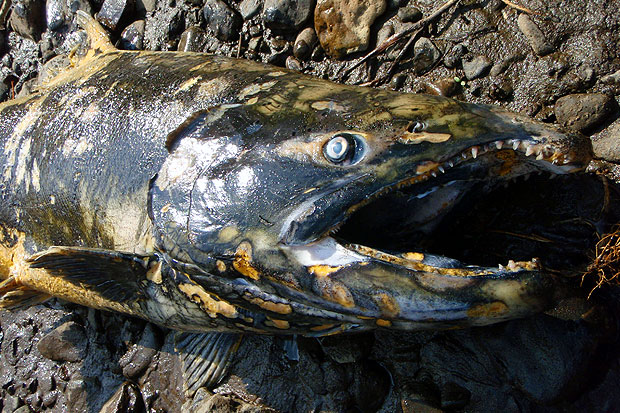
Springers have evolved to come first and swim the longest. They look to arrive early and get as far up the river as possible. Springers are typically different in that they have higher levels of fat. They load themselves up because they know their swim will be longer than that of the other salmon. This is why they are considered the best Chinook to catch; they simply taste the best! Springers have more energy than the next run: Tule. They swim much longer, can jump higher, and spend much more time in the river – and less time in the Columbia. Due to this higher energy, there were Springers on the White Salmon which spawned below and above Husum Falls (although not many).
Tule are the next run and are the most popular in the White Salmon. Tule come in early fall. They spend a lot of time getting up the Columbia, unlike the Springers. When they arrive, they are very lethargic and looking for a place to spawn immediately. It seemed like this year the Tule could not make it up Steelhead Falls. A week ago the entire bottom stretch of the river, from Steelhead to the mouth, was full of Tule spawning.
Up River Brights come next. They charge in from the ocean as the fall rains begin. Like the Springers, they prefer a top-down spawning approach, so they are trying to get as far up the river as possible. They get their name for their coloring, which is much brighter than the Tule. We’re right in the middle of the Bright run now. If you do a lap down the Lower Lower, you’ll see plenty of beautiful red salmon making their way upstream.
Jacks and Jills can be salmon from any run. They are essentially just confused salmon. They run when they’re a year old, rather than three. For this reason they are only about 1/6th of the size of a mature salmon. Jacks are males and are much more common to see, whereas Jills are females and are rare.
Natives are salmon that were not born in a hatchery. You can tell because these salmon will still have their adipose fin, or the small fin on the top of the fish furthest towards the back. Hatchery fish or Pellet Heads are generally a lot easier to catch, less intelligent, and not as hard of fighters as the Natives (local fisherman call them pellet heads because they’re fed pellets at a young age. When they’re released, they eat everything.). Native salmon populations all over the world are diminishing.
Kings are just Chinook in general. They’re called King Salmon because they’re the largest of the Pacific salmon.
On to what you’re all concerned about: How did the Condit Dam removal affect these fish?
As I said earlier, there were a few spring salmon that came up and made it well past the former Dam site. These salmon were essentially strays – lost from their home river, they made a stop in the White Salmon and for some reason decided to start swimming upstream. This season we saw spring salmon spawning in the pool above Rattlesnake, jumping up Husum, spawning below Sharks Tooth rapid, and attempting to jump up BZ Falls.
The Tule run did not seem to be able to make it up Steelhead Falls, which is below the old Dam site – but that does not mean the Dam removal didn’t also affect their habitat. If you’ve been following the removal, you know that it brought a massive amount of sediment and rocks held behind the Dam. Those rocks were deposited downstream, and the sediment was carried out to the mouth. This created miles and miles of new habitat for these salmon to make their reds, as a rocky bottom is essential.
The Brights are running now. I’ve seen a few past Steelhead. Time will tell if they can also make it up the other drops on the river.
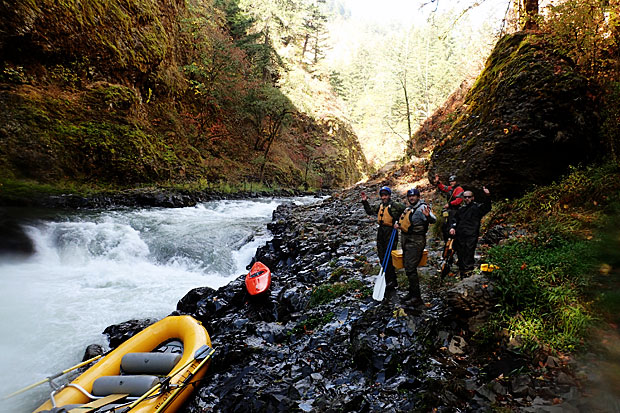
What does Fish and Wildlife actually do out there?
We floated downstream once a week during the Tule run. I rowed, someone in the boat counted live fish, and someone marked reds on a map. When a carcass was found, we pulled it out. They first measured the fish, identified its sex, and decided if it successfully spawned (the wear of the tail is a good indication of if the fish has spawned. They use their tails to dig their reds – so if their tails are worn down, they have spawned). They took a scale sample, a DNA sample, so they know for sure which run/river it came from, and finally they removed the ear bones. The ear bone grows like a tree, so they can use it to age the fish. When they finished with the carcass, they cut the tail off (so it won’t be sampled again) and threw it back in the river.
I’m not a Fish Biologist like the folks I worked with, so I won’t make statements about the return of the salmon as I honestly don’t know. I do know that I have seen and caught salmon (and a lot of steelhead) above the Dam site. I’ve also seen a few Springers spawning above the Dam site. I’ve seen a LOT of Tule spawning in new habitat that was deposited by the Dam removal. Also, at LEAST 50% of the fish we sampled were Native, if not 75%. Hopefully the salmon can make a full recovery and the White Salmon will have a wild run (although with the current Hatchery program, the chances of this are still slim).
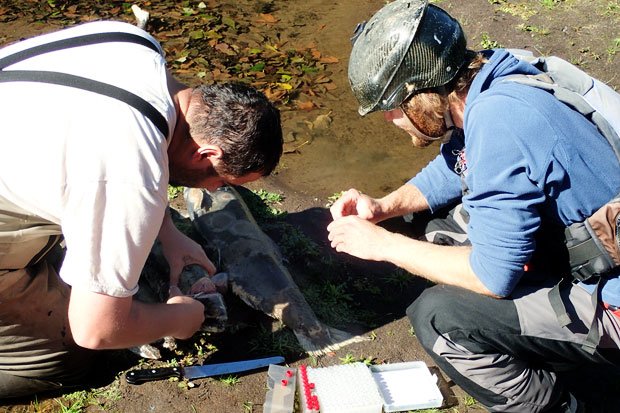
What can you do to help these fish?
If you’re a boater, Fish and Wildlife’s one request is to not disturb the reds. This is mostly a concern on the Lower Lower. Try to stay off the bottom of the river. Reds look like a large grey indentation on the bottom. If you’re boating in a big group, try to stay close to not disturb the salmon. They’re pretty awesome to watch and will tolerate a lot of “contact,” but do not intentionally disturb them. If you see a salmon swimming in the same spot for a long time, it’s probably defending its red. Leave it alone and enjoy the show.
If you’re a fisherman(woman), respect all the added rules and regulations of the White Salmon. No barbs, single hooks, or bait above the burnt bridge. You don’t want to catch salmon which are spawning as they’re covered in fungus and wounds. If they’ve made it to their red – leave them be. Don’t keep the Natives, and if you get one on your line, try to be as gentile as possible.
Overall, the Lower Lower White Salmon is a magical place to be right now. Fall boating is beautiful to begin with, and the added site of tons of huge salmon makes it pretty awesome. If the Lower Lower is in your skill range, I’d recommend floating down and talking a look at all the salmon. If you’re not a boater, there are plenty of places you can hike in to see salmon, the best being just below the burnt bridge.
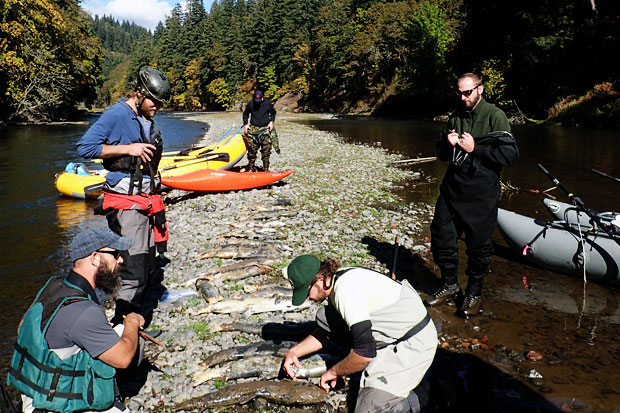
About the author: Jared Van Denend is a raft guide at Wet Planet and enjoys his free time fishing, kayaking, hiking, and climbing.

